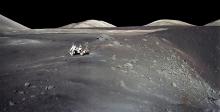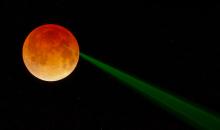Listen to today's episode of StarDate on the web the same day it airs in high-quality streaming audio without any extra ads or announcements. Choose a $8 one-month pass, or listen every day for a year for just $30.
You are here
Apollo 16
Six Apollo missions put astronauts on the Moon. Each flight carried three men. Two of them landed, while the third stayed aboard the command module in lunar orbit. On the surface, astronauts gathered rocks, took pictures, and set up experiments. But the guys they left behind could be just as busy.
Consider Ken Mattingly, the command module pilot for Apollo 16, which arrived at the Moon 50 years ago today. Mattingly stayed in orbit, about 70 miles up, while crewmates John Young and Charles Duke spent three days on the surface.
Mattingly operated a suite of scientific instruments. The gear included cameras, which mapped about six percent of the Moon in high resolution. It also included instruments that mapped the mineral and chemical composition of the ground below, probed for magnetic fields, and looked for traces of an atmosphere. Mattingly also used binoculars to help make his own observations of the Moon.
After Young and Duke rejoined him, they dropped a small satellite into lunar orbit. It was designed to study the solar wind, plus the Moon’s magnetic and gravitational fields. It operated for several weeks before it crashed into the Moon.
During the trip home, Mattingly took a spacewalk — about 200,000 miles from Earth. He plucked film from the cameras, and took out a package containing microscopic life to see how the organisms reacted to space — final chores for a “solo” lunar explorer.
More about Apollo 16 tomorrow.
Script by Damond Benningfield






